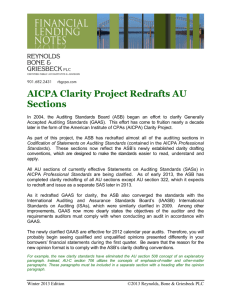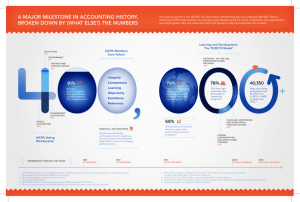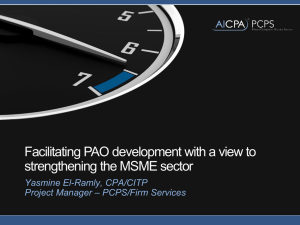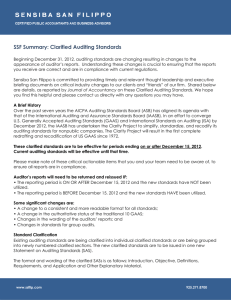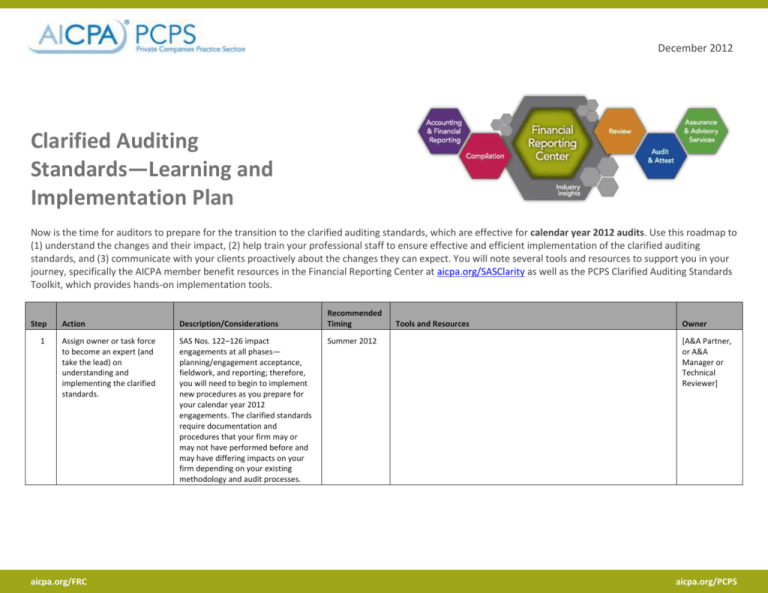
December 2012
Clarified Auditing
Standards—Learning and
Implementation Plan
Now is the time for auditors to prepare for the transition to the clarified auditing standards, which are effective for calendar year 2012 audits. Use this roadmap to
(1) understand the changes and their impact, (2) help train your professional staff to ensure effective and efficient implementation of the clarified auditing
standards, and (3) communicate with your clients proactively about the changes they can expect. You will note several tools and resources to support you in your
journey, specifically the AICPA member benefit resources in the Financial Reporting Center at aicpa.org/SASClarity as well as the PCPS Clarified Auditing Standards
Toolkit, which provides hands-on implementation tools.
Step
1
Action
Description/Considerations
Assign owner or task force
to become an expert (and
take the lead) on
understanding and
implementing the clarified
standards.
SAS Nos. 122–126 impact
engagements at all phases—
planning/engagement acceptance,
fieldwork, and reporting; therefore,
you will need to begin to implement
new procedures as you prepare for
your calendar year 2012
engagements. The clarified standards
require documentation and
procedures that your firm may or
may not have performed before and
may have differing impacts on your
firm depending on your existing
methodology and audit processes.
aicpa.org/FRC
Recommended
Timing
Summer 2012
Tools and Resources
Owner
[A&A Partner,
or A&A
Manager or
Technical
Reviewer]
aicpa.org/PCPS
Step
2
Action
Description/Considerations
Familiarize yourself with the
clarified standards.
AICPA members, start your engines
and use the resources in the Financial
Reporting Center for exploring the
new standards and the changes from
previous standards. The Summary of
Differences Between Clarified SASs
and Existing SASs and the Preface Snapshot Overview will jump start
your learning process while the Video
Clips provide further practitioner
insights into potential impacts on
your practice.
PCPS members, go the next mile and
access the resources that are found in
the PCPS Clarified Auditing Standards
Toolkit, including the Snapshot
Overview, written in plain English, to
help you understanding what is
different, how the work on your desk
may change, and also identify auditor
and client considerations. Review the
AU-C Sections Map to familiarize
yourself with the layout of the new
standards.
Recommended
Timing
Summer 2012
Tools and Resources
Owner
AICPA’s Financial Reporting Center
Clarity Project: Questions and Answers
Summary of Differences Between Clarified SASs and Existing SASs
Preface - Snapshot Overview
Video Clips for Auditors
[Assigned
owner or task
force]
PCPS Clarified Auditing Standards Toolkit (AICPA’s PCPS Section members
only)
Snapshot Overview
AU-C Sections Map
Publications
AICPA Audit Risk Alert Understanding the Clarified Auditing
Standards
Professional Standards and Codification of Statements on Auditing
Standards
CPE
On Demand Course – Understanding the Clarity Project
Webcasts - Clarity Standards Webcast Series (December 20, 2012)
Additionally, the publications and CPE
courses are key to augment your
understanding of the new standards.
The Audit Risk Alert will likely prove
valuable in providing insight to the
“need to know” items.
aicpa.org/FRC
aicpa.org/PCPS
Step
3
Action
Description/Considerations
Take a deeper look into the
substantive changes from
the extant standards and
evaluate the impact on your
firm’s engagements.
The following AU-C sections are
considered likely to affect your firm’s
audit methodology and engagements
because they contain substantive
changes:
Consideration of Laws and
Regulations (AU-C 250)
Communicating Internal Control
Related Matters (AU-C 265)
Related Parties (AU-C 550)
Group Audits (AU-C 600)
Auditors Reports (AU-C 700,
705, and 706)
The Snapshot Overview highlights
potential auditor and client
considerations that may be useful in
making this evaluation of the impact
on your firms engagements. The
Summary of Differences Between
Clarified SASs and Existing SASs
highlights the substantive changes
listed above from the extant
standards.
aicpa.org/FRC
Recommended
Timing
Summer 2012
Tools and Resources
Owner
AICPA’s Financial Reporting Center
Summary of Differences Between Clarified SASs and Existing SASs
Summary of Clarified Auditing Reporting Standards
Video Clips for Auditors
[Assigned
owner or task
force]
PCPS Clarified Auditing StandardsToolkit (AICPA’s PCPS members only)
Snapshot Overview
Publications
Audit Risk Alert Understanding the Clarified Auditing Standards
Audit Risk Alert Understanding the Responsibilities of Auditors for
Audits of Group Financial Statements
Reporting Manual
Related Party Practice Aid
CPE
On Demand Course – Understanding the Clarity Project
Webcasts - Clarity Standards Webcast Series (December 20, 2012)
aicpa.org/PCPS
Step
4
Action
Description/Considerations
Apply what you have
learned about changes in
auditing standards to your
firm’s audit methodology
and guidance. Consider
potential impacts to the
audits your firm performs.
Revise your firm guidance and audit
methodology to reflect the clarified
auditing standards.
Even if your firm uses a third-party
provided methodology, ensure you
understand the new standards and
how the methodology provider has
implemented them into their solution.
Recommended
Timing
Summer 2012
Tools and Resources
Owner
AICPA’s Financial Reporting Center
Scalability of Generally Accepted Audting Standards According to
the Size and Complexity of an Entity
Summary of Differences Between Clarified SASs and Existing SASs
[Assigned
owner or task
force]
PCPS Clarified Auditing Standards Toolkit (AICPA’s PCPS members only)
Snapshot Overview
Publications
Professional Standards and Codification of Statements on Auditing
Standards
AICPA Audit Guides (fully conformed to the clarified standards in
the 2012 editions)
Industry-specific AICPA Audit and Accounting Guides will reference
substantive changes in the 2012 editions and then will be fully
conformed in the 2013 editions
Through your understanding of the
standards, you may find more
efficient and effective ways to comply
with the standards than completing
every step in a commercially available
methodology; thus saving your
engagement team’s time and money.
Ensure a quality review of the
revisions to your firm guidance and
audit methodology occurs.
aicpa.org/FRC
CPE
On Demand Course – Understanding the Clarity Project
Webcasts - Clarity Standards Webcast Series (December 20, 2012)
aicpa.org/PCPS
Step
5
Action
Description/Considerations
Facilitate training for your
professional staff and
partner group.
A smooth transition to the clarified
standards requires planning,
information, education, and training
for all audit staff.
PCPS member firms, shift your
practice into high gear and facilitate a
training session using the Staff
Training PowerPoint template. Tailor
the PowerPoint to fit your firm’s
needs considering your client base
and existing methodology. Consider
providing the Snapshot Overview as a
handout to professional staff during
training.
Recommended
Timing
Summer 2012
Tools and Resources
Owner
AICPA’s Financial Reporting Center
Summary of Differences Between Clarified SASs and Existing SASs
Auditing Standards Board Clarity Project Powerpoint Presentation
Video Clips for Auditors
[Assigned
owner or task
force]
PCPS Clarified Auditing StandardsToolkit (AICPA’s PCPS members only)
Staff Training PowerPoint
Snapshot Overview
Publications
Professional Standards and Codification of Statements on Auditing
Standards
AICPA Audit Guides (fully conformed to the clarified standards in
the 2012 editions)
Industry-specific AICPA Audit and Accounting Guides will reference
substantive changes in the 2012 editions and then will be fully
conformed in the 2013 editions
CPE
aicpa.org/FRC
On Demand Course – Understanding the Clarity Project
Webcasts - Clarity Standards Webcast Series (December 20, 2012)
aicpa.org/PCPS
Step
6
Action
Description/Considerations
Determine how the clarified
auditing standards may
impact each audit
engagement and prepare for
potential client concerns
that may need to be
addressed. The clarified
auditing standards provide
special considerations for
smaller, less complex
organizations or
governmental entities.
Review the Q&A’s relating to
scalability for size and complexity
considerations for your client base.
Recommended
Timing
Summer–Fall
2012
Note that revised Yellow Book
(GAGAS) standards will become
effective at the same time as the
clarified standards for auditors of
governmental units.
Ensure Engagement Letters,
Auditor’s Reports, and
Management
Representation Letters are
all updated to incorporate
new required language.
PCPS member firms, utilize the Client
Considerations Evaluation Worksheet
to evaluate the impact for each client
on a case-by-case basis. Consider
having the engagement team
complete the worksheet prior to
planning the audit to ensure the
potential impact to scope and fees for
each specific engagement have been
considered. The worksheet can also
be used to prepare to address client
specific circumstances and possible
client concerns.
aicpa.org/FRC
The resources listed here provide
example engagement letters and
reports for use on your audits.
The clarified auditing standards,
available in Professional Standards
contain examples of engagment
letters and new reports. PCPS
members, you also have access to
comparison examples of previous
report letters and new report letters
along with a sample engagement
letter inthe exhibits within the
Snapshot Overview.
Owner
AICPA’s Financial Reporting Center
Summary of Differences Between Clarified SASs and Existing SASs
Scalability of Generally Accepted Auditing Standards According to
the Size and Complexity of an Entity
Auditing Standards Board Clarity Project Powerpoint presentation
Video Clips for Auditors
[Assigned
owner or task
force]
PCPS Clarified Auditing StandardsToolkit (AICPA’s PCPS members only)
Client Considerations Evaluation Worksheet
Publications
Audit Risk Alert Understanding the Responsibilities of Auditors for
Audits of Group Financial Statements
Practice Aid Using an SSAE No. 16 Service Auditor's Report (SOC 1
Report) in a Financial Statement Audit
Guide Auditing Fair Value
AICPA Audit Guides (fully conformed to the clarified standards in
the 2012 editions)
Industry-specific AICPA Audit and Accounting Guides will reference
substantive changes in the 2012 editions and then will be fully
conformed in the 2013 editions
CPE
Further, topical and industry specific
guidance is also available.
7
Tools and Resources
Summer 2012
On Demand Course – Understanding the Clarity Project
Webcasts - Clarity Standards Webcast Series (December 20, 2012)
AICPA’s Financial Reporting Center
Summary of Clarified Auditing Reporting Standards
PCPS Clarified Auditing Standards Toolkit (AICPA’s PCPS members only)
Snapshot Overview (exhibits)
[Assigned
owner or task
force]
Publications
Professional Standards and Codification of Statements on Auditing
Standards
The AICPA’s Audit Risk Alert Understanding the Clarified Auditing
Standards
The Engagement Letter: Best Practices and Examples
The Auditor’s Report: Comprehensive Guidance and Examples
aicpa.org/PCPS
Step
8
Action
Description/Considerations
Communicate with your
clients.
Although early implementation is not
permitted, several changes have been
created that may require early
discussions with clients. In addition,
some of the changes may impact the
acceptance of certain engagements
by an auditor.
To make the transition to the new
standards go smoothly, you may want
to identify the changes specific to
your clients on a case by case basis
(step 6). Then consider scheduling
meetings with each client to address
their specific engagement and discuss
scope changes and fees.
Recommended
Timing
Summer 2012
Tools and Resources
Owner
PCPS Clarified Auditing StandardsToolkit (AICPA’s PCPS members only)
Client Considerations Evaluation Worksheet
Client Letter Template
Website/Client Newsletter Template
[Assigned
owner or task
force ]
Publications
The AICPA’s Audit Risk Alert Understanding the Clarified Auditing
Standards
The Engagement Letter: Best Practices and Examples
Access the PCPS Clarified Auditing
Standards Toolkit for these resources;
a Client Letter template can be
tailored to give clients a general
“heads up” on the new audit
requirements. The Website/Client
Newsletter template will allow you to
more broadly communicate general
expected changes in upcoming audits.
DISCLAIMER: This publication has not been approved, disapproved or otherwise acted upon by any senior technical committees of, and does not represent an official position of, the American Institute of Certified Public Accountants. It is
distributed with the understanding that the contributing authors and editors, and the publisher, are not rendering legal, accounting, or other professional services in this publication. If legal advice or other expert assistance is required, the
services of a competent professional should be sought.
Copyright © 2012 by American Institute of Certified Public Accountants, Inc. New York, NY 10036-8775. All rights reserved. For information about the procedure for requesting permission to make copies of any part of this work, please
email copyright@aicpa.org with your request. Otherwise, requests should be written and mailed to the Permissions Department, AICPA, 220 Leigh Farm Road, Durham, NC 27707-8110.
aicpa.org/FRC
aicpa.org/PCPS

